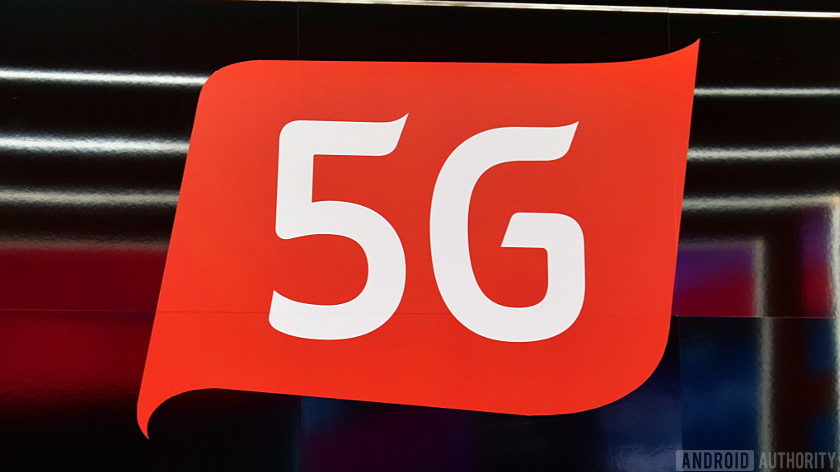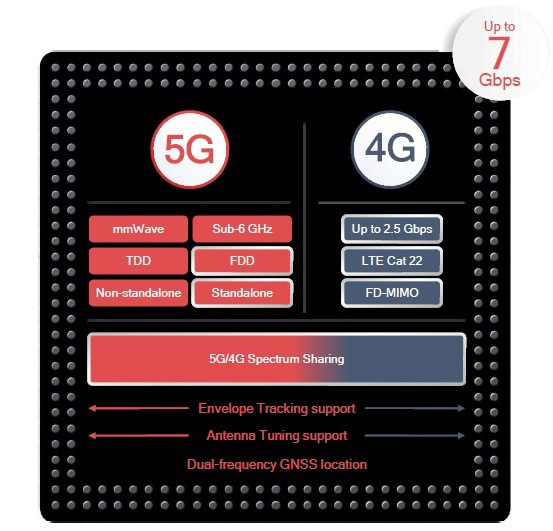Affiliate links on Android Authority may earn us a commission. Learn more.
Qualcomm's Snapdragon X55 modem is the 4G/5G solution we've been waiting for

Today, Qualcomm has unveiled its latest 5G modem, the Qualcomm Snapdragon X55. The chip is the company’s second-generation 5G modem and successor to the Snapdragon X50 that was announced back in 2017. Headline features of this new chip include multi-mode 4G and 5G in a single chip, blazing fast 7Gbps speeds, and futureproof support for the 5G Standalone specification.

In addition to the new modem, Qualcomm also announced its second-generation mmWave antenna and will be demoing its 5G technologies at MWC. Dubbed the QTM525, the latest antenna module is slightly slimmer than the previous design and can be built into phones thinner than 8mm thick. It now covers 26, 28, and 39GHz mmWave spectrum and Qualcomm continues to suggest that three or four of these will be needed per 5G phone.
Inside the Snapdragon X55
There’s a lot to the Snapdragon X55, so let’s break it down into 4G and 5G parts.
Starting with 5G, the chip supports both mmWave and sub-6GHz spectrum, just like its predecessor. Theoretical peak speeds are boosted from 5Gbps to 7Gbps download and up to 3Gbps upload. However, you’ll need a perfect alignment of network conditions and capabilities to reach such lofty speeds.
More important is the introduction of 5G FDD support. This will be crucial in Europe and other places looking to free up low-frequency spectrum (600 to 900MHz) for 5G. The Snapdragon X55 also introduces 4G/5G spectrum sharing, 100MHz envelope tracking for better power management, and antenna tuning in the sub-6GHz region. All very handy improvements over its first generation 5G modem.
Perhaps the biggest point of all is that the X55 also supports the 5G Standalone (SA) specification. First-generation 5G networks and devices are all based on the earlier Non-Standalone (NSA) specification. Eventually, these will transition over to the SA standard. SA ditches the use of LTE networks for backend communication, transitioning over entirely to 5G. This opens up greater networking flexibility with Network Slicing and offers even lower latency for IoT and device-to-device communication.

Read more: 5G Standalone vs Non-Standalone explained
On the 4G side, the Snapdragon X55 supports the Category 22 LTE standard. This allows for peak throughput of 2.5Gbps, making it Qualcomm’s most powerful 4G solution to date. The Snapdragon X55 also introduces Full Dimensional MIMO (FD-MIMO) for LTE. This includes 3D beamforming, allowing for improved elevation support to improve spectrum efficiency.
Built for a next-gen Snapdragon SoC?
The Snapdragon X55 isn’t expected to appear in devices until late 2019. Therefore the first wave of 5G smartphones will all be built using an external X50 in conjunction with a Snapdragon 855, which provides the 4G LTE modem. This has always been a less than ideal situation, as an external modem requires extra silicon and PCB space as well as consuming more power. Ideally, the 5G modem is built into a smartphone SoC like today’s 4G modems are.
Qualcomm hasn’t confirmed this, but to me, it seems almost certain that the X55 will feature inside 2019’s next-gen Snapdragon 8XX processor. This chip is typically announced at the end of the year, close to when Qualcomm expects the first X55 products.
Importantly, the Snapdragon X55 is built on a 7nm process rather than 10nm with the X50. This should match the process used in the next-gen SoC, making integration more feasible. With the 5G SA specification now essentially finalized, Qualcomm’s latest modem is future proofed and it’s therefore now worth spending the time designing an integrated version. Finally, the fact that the chip is 4G and 5G compliant means that it will work across all markets, so there’s little reason not to integrate as 5G becomes more prevalent throughout 2019. But that’s just my thinking.

Looking beyond smartphones
While the Snapdragon X50 was all about smartphones, the X55 is looking at broader use cases. Qualcomm designed the modem to be “much more flexible” than its predecessor. As a standalone solution, the modem could be used in fixed wireless hotspots, laptops and tablets, and automotive devices. In smartphones, the X55 will undoubtedly replace the X50 in 2020 and could find its way into an integrated SoC by the end of the year.
The Snapdragon X55 is an important announcement for 5G devices. Just like some of the company’s competitors, Qualcomm now offers an all in-one modem solution for current and next-gen networks. This will facilitate an easier 5G transition for device and carrier providers. Furthermore, with 5G SA in tow, X55 equipped phones will be future proofed as we head towards fully fledged 5G networks after 2021.